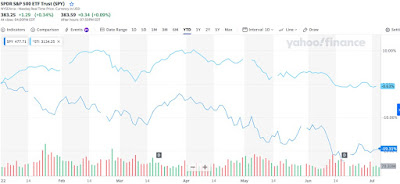Note: I am not trying to spread FUD here. I am just doing some research and thought it was a good topic to write about.
To combat inflation, the Fed has been raising rates. The current Federal Reserve rate ranges from 1.5 percent to 1.75 percent. The Fed is expected to raise rates from 3.25 percent to 3.5 percent by the end of 2022. This has resulted in a bear market in the United States and predictions of a possible recession. As a result, investors are seeking a safe haven in which to invest. The STI Index is seen as a safe haven by some. This is implied by the 0.63 percent YTD decrease in the STI vs. the 19.3 percent drop in the SPY ETF, as shown below.
 |
| SPY vs STI. Screenshot from Yahoo Finance |
My Chain of Thoughts:
1. Many investors are drawn to the SG market because of the prospective dividend payout. Currently, based on its current price, STI provides a potential 3%
dividend yield.
2.
SSB is now giving 2% for a one-year holding period and 3% for a ten-year holding period.
3. If the Fed interest rate is hiked to 3.25 percent by the end of 2022, the SSB might give 4% to 5% for a 10-year holding term.
4. Share prices will have to fall in order for the risk premium to be acceptable.
Q: How much should STI share price come down?
To simplify matters, I will just base my understanding on the following 2 formulas:
1-year short-term SSB Risk-Free Rate (2%) - Current Fed Interest Rate = SSB Spread
Dividend Yield - 1-year short-term SSB Risk-Free Rate (2%) = Risk Premium.
SSB spread is between 0.25% to 0.5%.
STI Risk Premium is around 1%.
If the Fed rate was to increase to 3.25% by end of 2022, STI dividend yield should be around 4.25%
 |
| STI dividend in 2021. Image from SGX |
The STI ETF share price may theoretically be S$1.953 based on the full year 2021 dividend of S$0.083 and a dividend yield of 4.25 percent. This is a 38% decrease from the current STI ETF share price of S$3.170.
Many people believe that the STI will fall to such low levels only if Singapore enters a recession.
However, it is vital to note that the three local banks account for 43 percent of the STI, which means that the local bank share price must fall by a comparable percentage.
STI components, on the other hand, are reviewed quarterly. This may alleviate some of the strain from the precipitous decline in its share price.
Conclusion
To begin with, even in a recession, I do not anticipate such a sharp decline in the STI. After all, this is a VERY SIMPLE CALCULATION that is DEFINITELY NOT ACCURATE.
However, a reduction in the share price of the STI ETF is unavoidable if the Fed continues to raise rates. Furthermore, during a recession, all businesses would be affected, and local banks will be unable to escape it
In my opinion, STI ETF will likely decrease to S$2.400 as of last March 2020 during the pandemic in the event of a recession.
Stay vested. Stay Safe.
If you had read till here and I have value-added to your investment journey, please support by clicking into the Google Ads if it interest you!
Appreciate!
Stay tuned for the next write up!


Your analysis may be more applicable to Reits index, as Reits are more affected by risk-free rates.
ReplyDeleteSTI is bank-heavy index. Banks earn more income when interest rate rises.
Hi ThinkNotLeft,
DeleteThanks for your comments and you are correct. I wrote this article with STI and REIT in mind. However, in a recession, banks will be affected too. I understand how they could earn more, but if more businesses fail and bankruptcy increases, the adverse effect on their finances will arise too.
Regards,
TUB